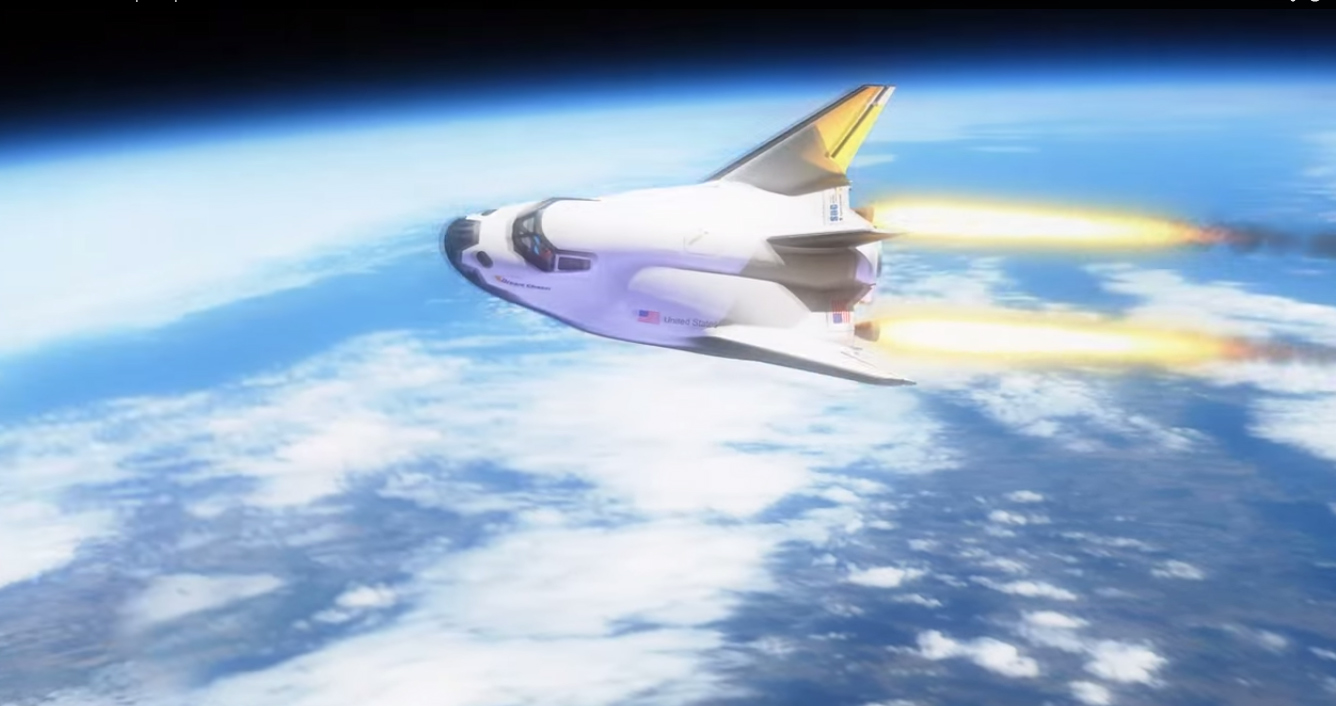
With the pace of assembly accelerating for the first private Dream Chaser space plane, plans for its maiden blastoff on an “orbital test flight on a fully autonomous mission in Nov. 2016″ are moving forward, Mark Sirangelo, corporate vice president of Sierra Nevada Corporation (SNC) Space Systems, told AmericaSpace in Part 3 of our exclusive, one-on-one interview about their efforts to build a cost-effective astronaut taxi to the International Space Station (ISS).
The first unmanned flight will be followed by the launch of the first manned Dream Chaser before the end of 2017, under NASA’s current timetable, Sirangelo stated.
The first manned Dream Chaser will launch with a two-person crew that is virtually certain to include one of two veteran former NASA astronauts and space shuttle commanders, now on staff at Sierra Nevada as managers and test pilots, Sirangelo elaborated.
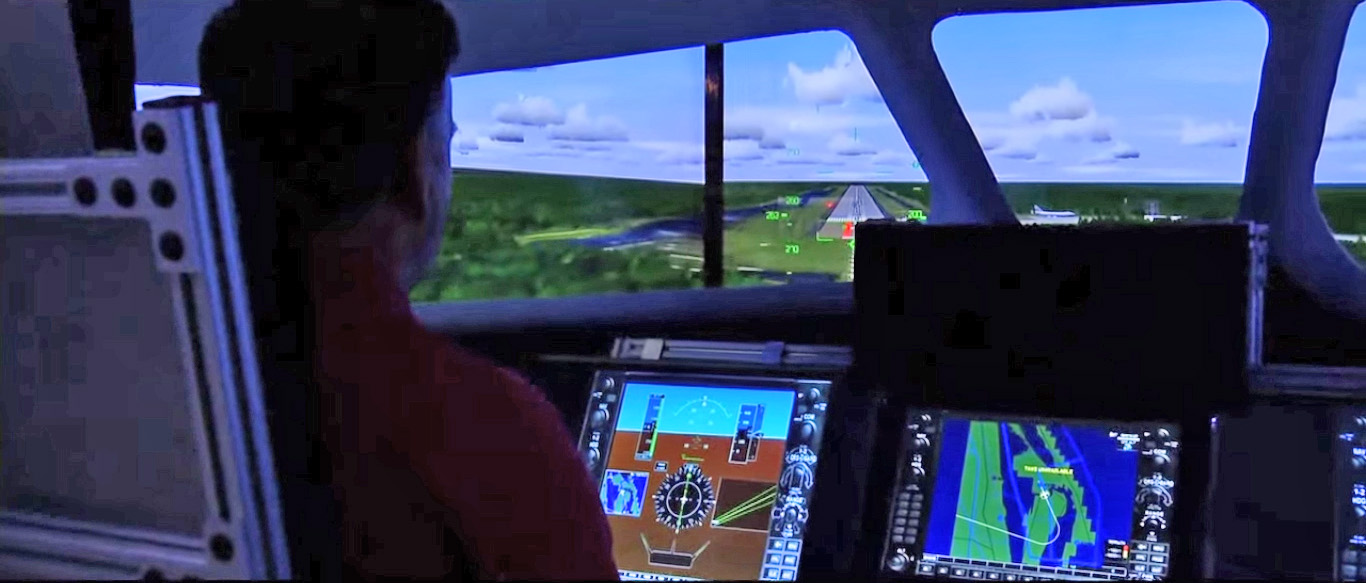
Dream Chaser is a reusable manned space plane being developed by SNC to restore America’s indigenous capability to ferry American astronauts from American soil to low-Earth orbit and the International Space Station (ISS), with funding from the Commercial Crew Integrated Capability initiative (CCiCAP) under the auspices of NASA’s Commercial Crew Program (CCP).
Three American aerospace firms—Sierra Nevada with Dream Chaser, Boeing with CST-100, and SpaceX with Dragon V2—are vying for NASA’s multi-billion dollar contracts to build private sector manned spaceships to fly astronauts to the space station by late 2017, using seed money from NASA’s Commercial Crew Program (CCP) in a public/private partnership.
In Part 1 of this series, Sirangelo described SNC’s assembly and upcoming free-flight drop test program for the atmospheric test vehicle that will pave the path to the eventual Dream Chaser orbital vehicle, just as the Enterprise did for NASA’s shuttle orbiters in the 1970s.
In Part 2, we focused on how SNC is boldly pushing forward with the orbital vehicle build, even before the winners of NASA’s highly coveted and prestigious commercial crew vehicle contracts are announced by NASA.
Now we’ll discuss the flight plans and crew for the first two missions in 2016 and 2017.
Describe the flight plans for the November 2016 unmanned flight and how the control will differ from the October 2013 free flight drop test.
“The first flight will be an orbital unmanned test. And it is fully autonomous. It’s not a UAV. We are not ground controlling it. The November 2016 flight is a fully autonomous mission and is controlled by the spaceship.”
“The first drop test mission [in Oct 26 2013] was not a fully autonomous mission. It was ground controlled.”
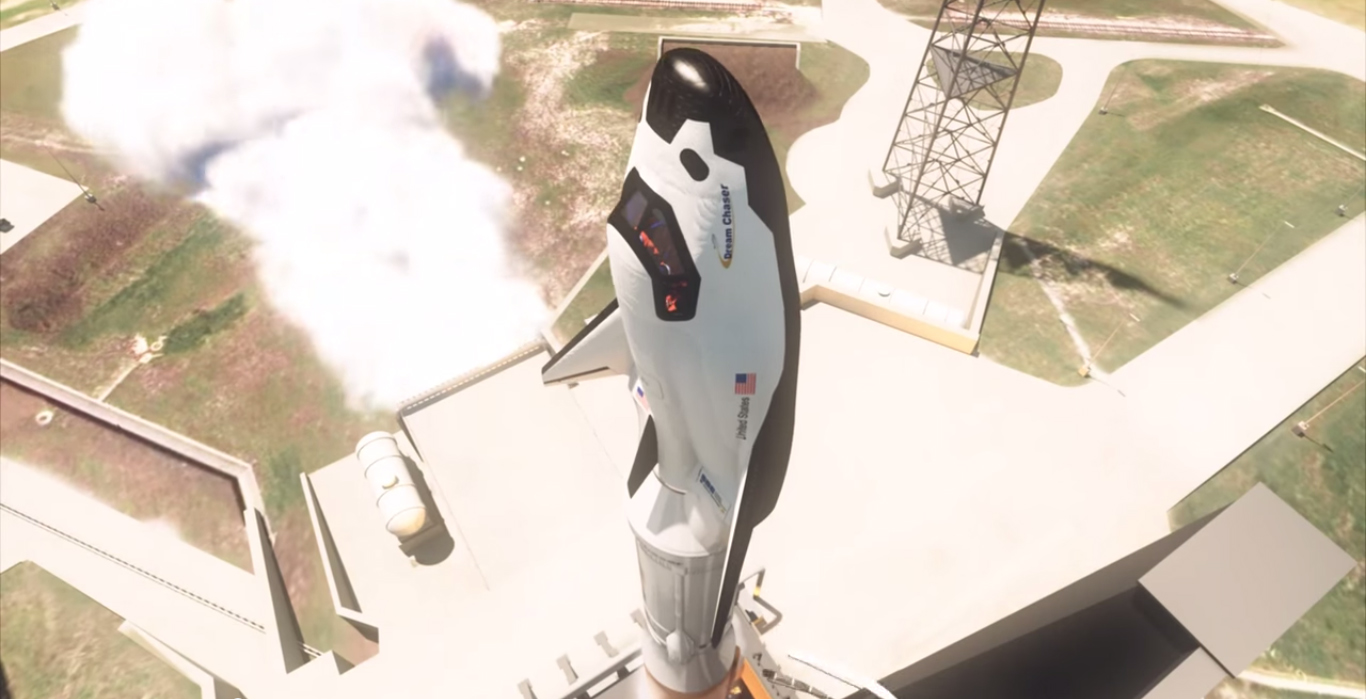
What are the on-orbit flight goals for Dream Chaser’s 2016 mission? It’s likely to be at least several orbits and perhaps even days long.
“For the November 2016 flight it will be a full orbital flight. We are launching using a full Atlas V in the same flight configuration as we would use to go to the space station with. We are flying on an Atlas V 412. The first stage has one strap on solid. We are lighter [compared to CST-100] and don’t need a second solid. The second stage uses a dual engine Centaur.”
“We will do an orbital flight with a series of checkouts of important elements of the vehicle and then we are flying it back home.”
For complete details regarding the Atlas V pad 41 modifications, read the AmericaSpace interview with ULA executives here.
Boeing’s Chris Ferguson said in an AmericaSpace interview that Boeing would like to go all the way to the ISS with the CST-100 on the first unmanned flight, if they satisfy NASA’s requirements. What are your plans for Dream Chaser?
“It’s unlikely that NASA will let any of us go the ISS without having their first flight demonstrated. But that’s still in the future.”
Would the next flight after the November 2016 unmanned test flight fly with an astronaut crew?
“Yes, the next flight would be a manned flight.”
Would that first manned flight go to the ISS? And what does that mean for system certification with NASA?
“We are hoping that NASA would want us to go the ISS. And then with those two flights—unmanned and manned—we would be fully certified by NASA for flight operations.”
But the actual manned launch date is entirely dependent on the U.S. Congress appropriating the funds for CCP requested by the Obama Administration.
To date, Congress has given NASA barely half its funding request and thereby already forced about an 18-month delay of the first manned commercial crew spacecraft to the ISS from 2015 to 2017, Chris Ferguson said in an earlier interview about the CST-100. The same is true for Sierra Nevada and SpaceX.
So the date of first launch could slip further into 2018, unless and until Congress acts!
NASA’s commercial crew outlook for the coming fiscal year is more promising, but Congress has thus far failed to pass a NASA budget, or much of anything else either.
In the time since the shuttle’s retirement in 2011, the U.S. is 100 percent dependent on the Russia Soyuz capsule for astronaut rides to the International Space Station (ISS) and back, at a cost now exceeding $70 million per seat.
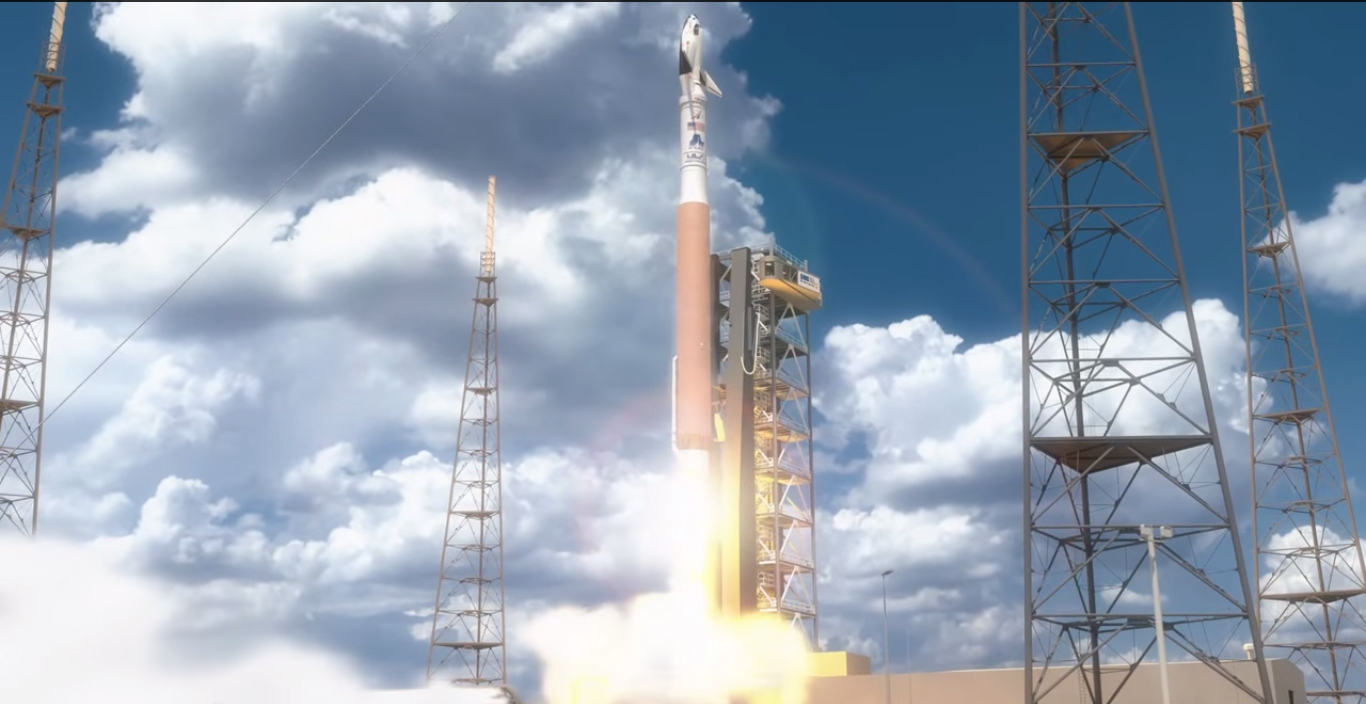
Dream Chaser is a reusable lifting-body design spaceship that will carry a mix of cargo and up to a seven crewmembers to the ISS. It will also be able to land on commercial runways anywhere in the world.
Who will be the astronauts on the first manned flight in 2017? SNC currently has two space shuttle flyers involved with Dream Chaser.
“It’s a little unclear at this time. Our two flight people [now] are Steve Lindsey, our senior program manager, and Lee Archambault.”
“Steve is a five time shuttle pilot and was the head of the astronaut office for three years.”
Lindsey was the commander of the final flight of Space Shuttle Discovery that launched on Feb. 24, 2011, and delivered the Permanent Multipurpose Module Leonardo, as well as Robonaut 2 to the ISS.
He was also a veteran of missions STS-87, STS-95, STS-104, and STS-121, and a three-time shuttle commander with over 1500 hours in space.
“Our flight director is Lee Archambault.”
Archambault is a veteran of two shuttle fights, STS-117 as pilot and STS-119 as commander. He has spent a combined 27 days in space. Both missions were ISS assembly flights carrying critical parts and hardware, including truss segments and the huge solar arrays.
“Lee is managing the flight test program and is likely to be one of the pilots as well.”
The upcoming free-flight drop test program this fall and into 2015—unmanned and manned—is detailed in Part 1.
Would the 2017 manned flight be a mixed crew of SNC test pilots and NASA astronauts? Boeing’s Chris Ferguson indicated in an interview that NASA might be leaning toward a mixed crew, which would be a change from NASA’s earlier thinking on it being two company test pilots.
“It’s a little unclear at this time. NASA has to decide whether they want to have one of their people on this first flight or not.”
“We will know that later. We don’t know that at this time.”
Could both Steve and Lee fly on that first manned flight in 2017?
“We haven’t decided that yet. They are both capable. We’ll make those decisions when we get there.”
Have you changed the Dream Chaser’s propulsion system from a hybrid solid/liquid system to an all liquid system as some have claimed recently, and as readers asked in Part 1?
“We have not announced a change in propulsion systems and that was not a quote from us.”
“It was likely meant to refer to our acquisition of Orbitec as we now have an expanded base of propulsion solutions and are exploring their use for future Dream Chaser variants.”
“There is no schedule change related to engines.”
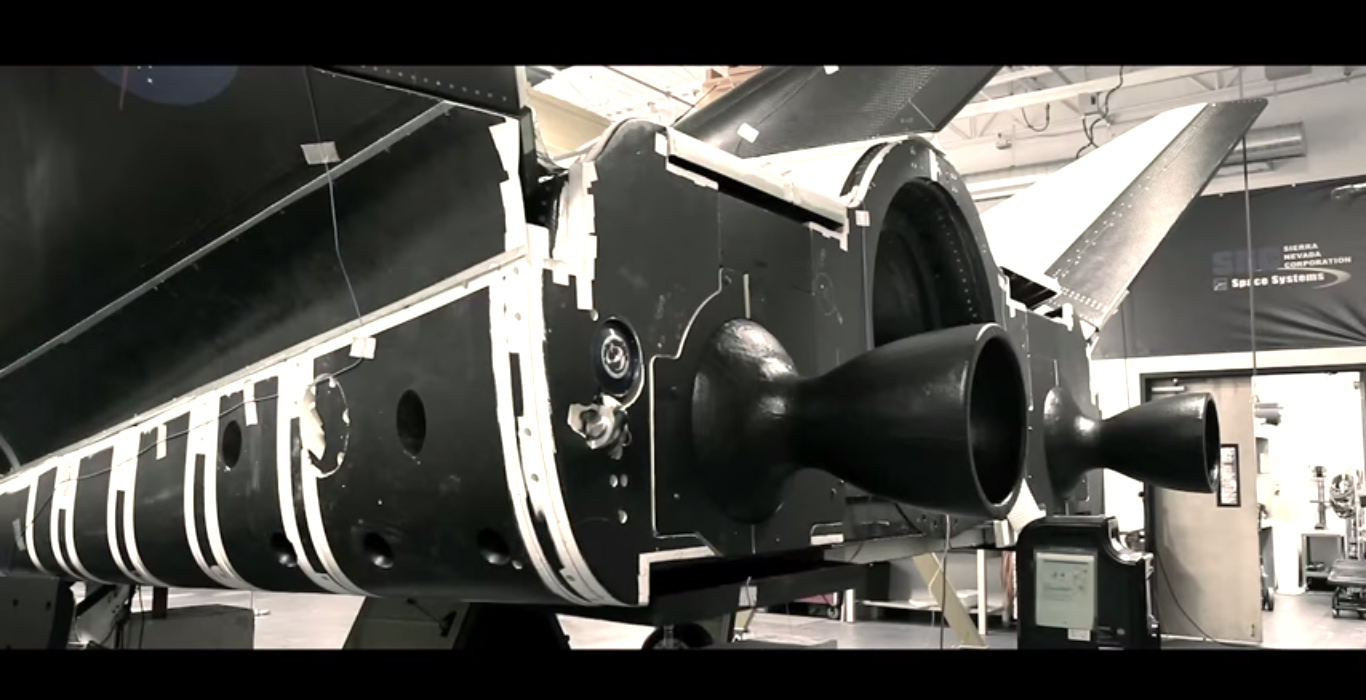
Describe the abort modes and plans for abort tests?
“One of the major features of Dream Chaser is its ability to abort safely to a runway landing from anywhere on the launch profile.”
“We call that having no black zones. This provides the highest degree of safety for the crew and also preserves vehicle and any payload that it may be carrying.”
“We are planning various abort element testing in the next phase but can’t release timing at this point.”
Why did you choose the Atlas V rocket, also chosen by Boeing to launch their CST-100 capsule?
“We chose the Atlas V because it is the safest and most used rocket that’s out there. And when we are dealing with crew or even critical cargo we wanted to start with something that was as safe and predictable as any rocket that’s out there.”
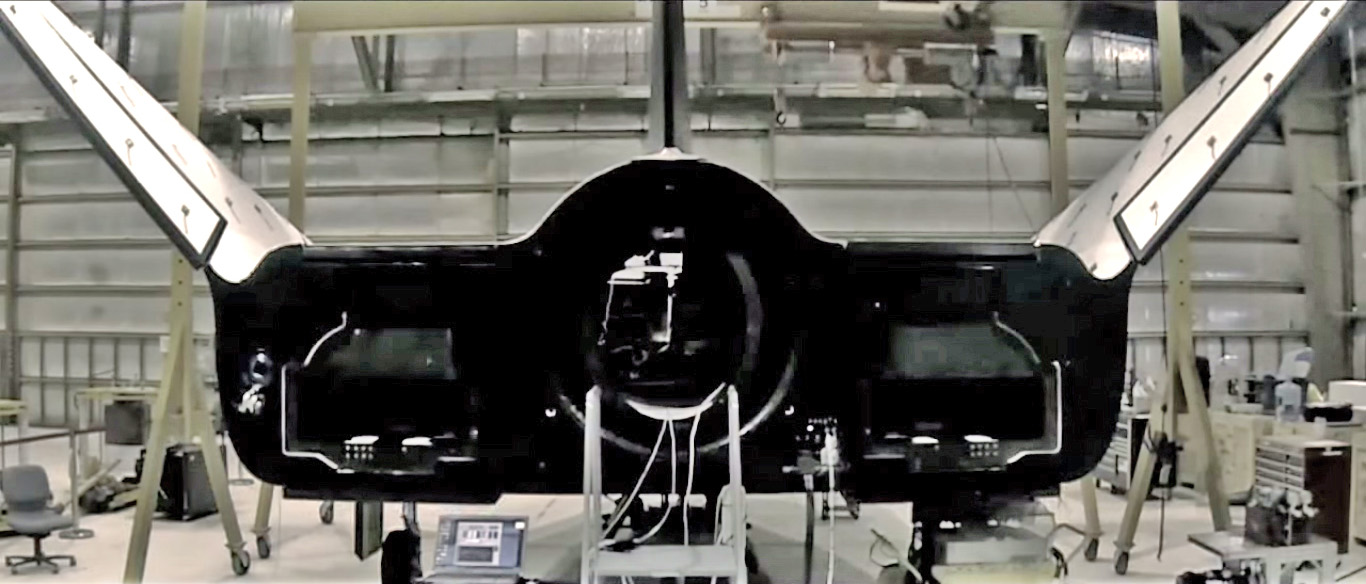
NASA’s Commercial Crew Program office is expected to announce the winner(s) of the high stakes, multi-billion dollar contract to build America’s next crew vehicles in the next program phase, known as Commercial Crew Transportation Capability (CCtCap), “sometime around the end of August/September,” NASA News spokesman Allard Beutel reconfirmed to this writer today.
“We don’t have a scheduled date for the commercial crew award(s).”
What happens to Dream Chaser if Sierra Nevada does not receive the CCtCAP contract from NASA? Do you go ahead anyway or stop?
“I get asked that question every day. The answer is we have to see why we didn’t get it. And then we have to determine what are our cost course to push forward,” Sirangelo replied.
“We have a lot of the hardware in place and a lot of things moving [read parts 1 and 2]. We believe we have a path with other relationships to continue.”
“But it’s going to be a question, for all three companies, is we have to evaluate what happened. Was it money issues or technical or something else. So we are not saying at this time what we are going to do or not do.”
“The closer we get to flight the more likely it is we can do other work also. NASA is an important part of this. But we have been laying the foundation with other relationships as well.”
“We have all the elements to be able to go ahead. Whether we go ahead is a matter of whether there is a business case for it. We can’t say at this time.”
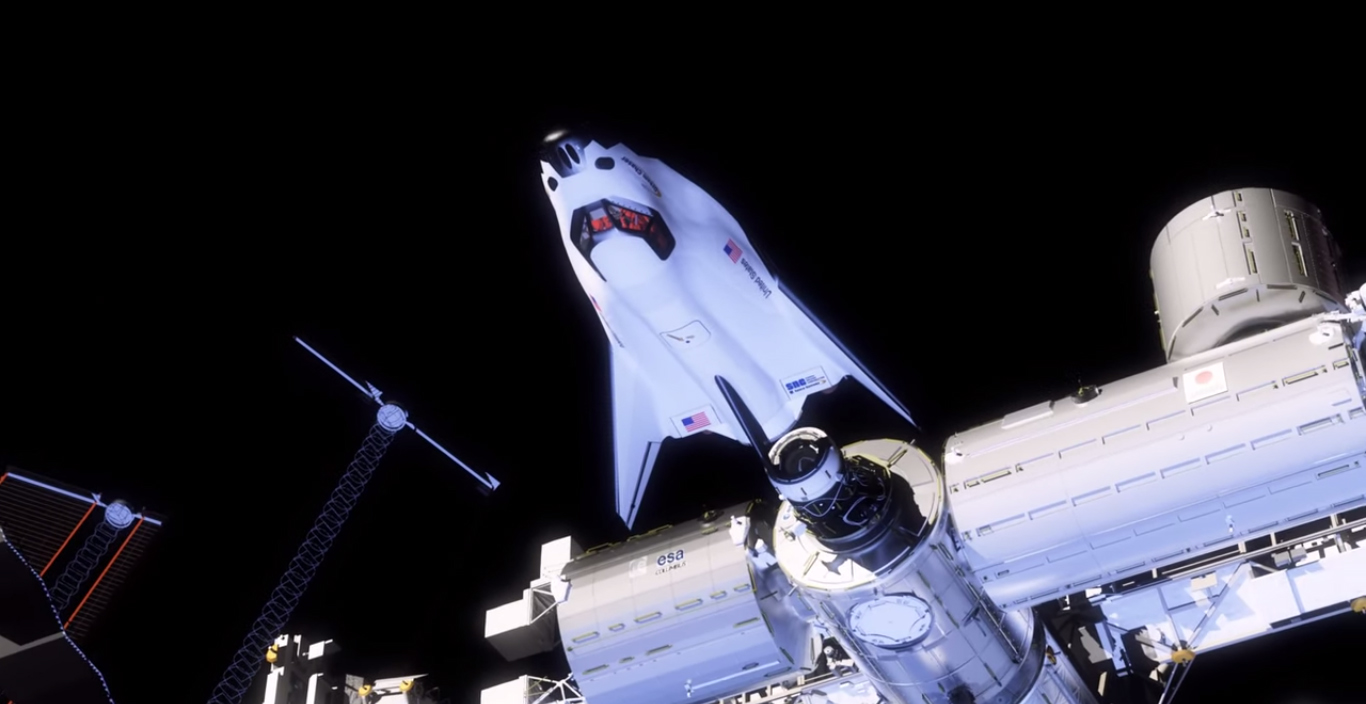
So no matter what happens, Sierra Nevada has laid the foundation to move forward by beginning to build the orbital vehicle and attracting numerous partners globally.
So there’s much more to this story. Find out how Dream Chaser could survive no matter what happens with CCP – in Part 4!
What are the details about future upgrades and variants of Dream Chaser? International partners?
Is Dream Chaser reusable? How flexible is it?
Any implications for flying autonomous?
What advantages does it offer compared to its other competitors, both of which are capsules: the Boeing CST-100 and SpaceX Dragon V2?
Tune in for Part 4 of my exclusive one-on-one interview with SNC VP Mark Sirangelo.
Be sure to read Part 1 and Part 2.
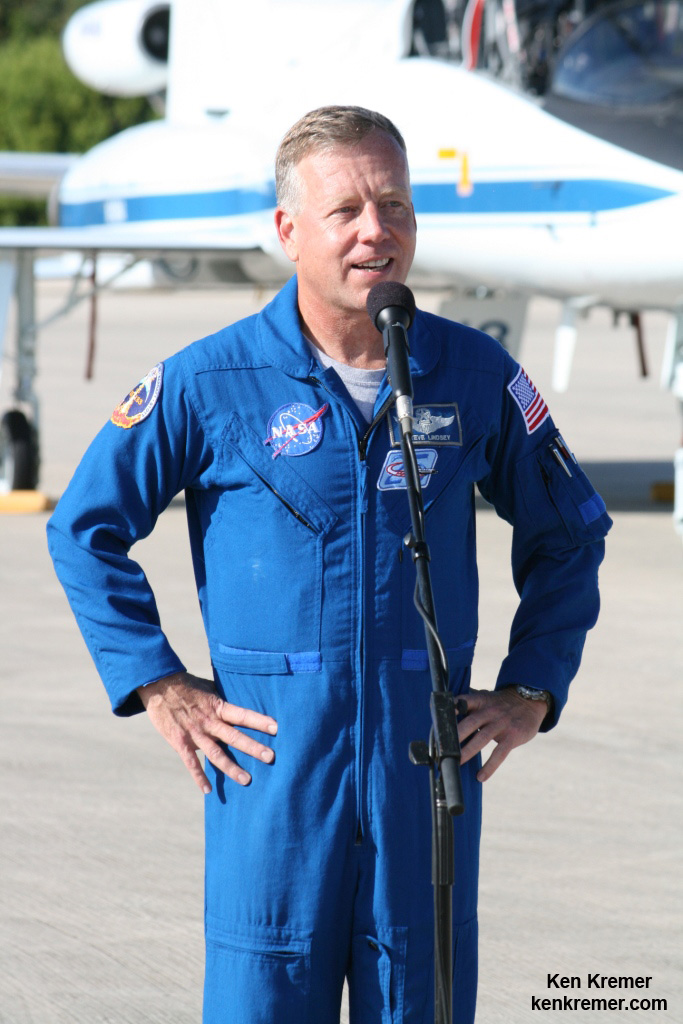
Stay tuned here for continuing developments.
Want to keep up-to-date with all things space? Be sure to “Like” AmericaSpace on Facebook and follow us on Twitter: @AmericaSpace
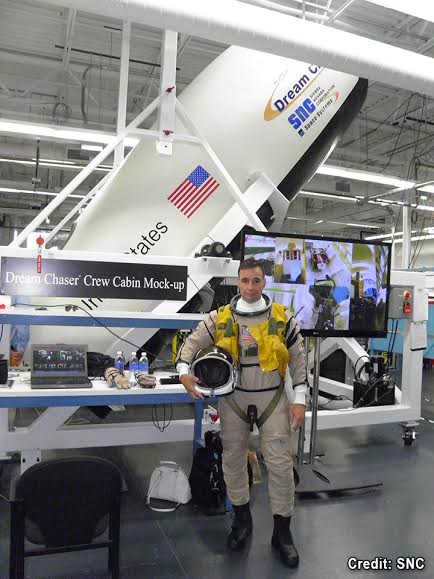
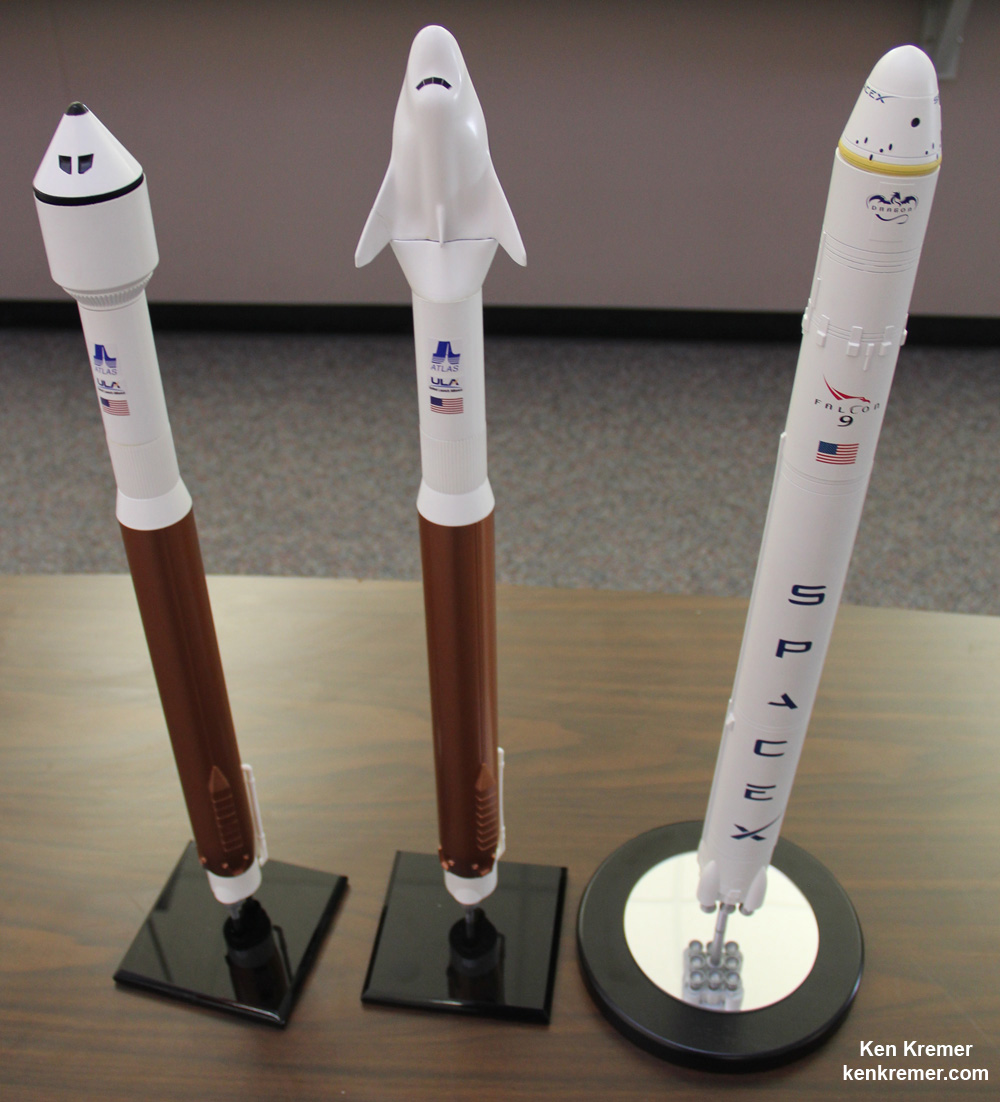




IMO, final result: Boeing is a standout first, SNC is second & SpaceX misses out.
Reasons;
It’s a slam dunk for Boeing. They are a known quantity with a known track record, their technological approach is tried & true and they are used to doing business the Government & NASA way plus they know how to look after the right people etc. They are that confident of being awarded the (main) contract, they have implied that if they are not successful, then they will “take their bat & ball and go home” i.e. as far as Boeing is concerned there is no business case to build CST-100 if no public funds are involved. Not that they necessarily would not proceed, but it permits the more experienced to say to the less experienced, “hey, we (meaning you) shouldn’t upset the “Big B””.
Congress wanted one provider, NASA wanted two, a main provider with a backup. NASA got its way because it really didn’t tread on any toes, it allowed NASA to have its little “victory”, doubly rewards Boeing (by having SNC as runner-up) and has the added advantage of providing a backup to CST-100 plus NASA has their Apollo style capsule and their “mini-me” shuttle.
For not placing SpaceX, Elon Musk is going to build Dragon regardless. He needs a delivery system to the Martian surface and Dragon’s it. It will take a brave person within NASA to select SpaceX, with their bold and innovative approach, which, if pulled off, will dramatically reduce overall costs. I just don’t see conservative old NASA having the “cahoonas” to go with SpaceX.
P.S. In my opinion, the real reason why SpaceX has put its hat in the Commercial Crew ring, even though it knows it doesn’t stand (much of) a chance, is to add pressure to the US Government to award it more of the DOD business being handed to ULA. This suits SpaceX better, Commercial Crew contract(s) come with all sorts of conditions & requirements which really doesn’t/won’t suit SpaceX’s way of doing business (which is just get on with it, do it fast, well & cost effectively). SpaceX not being awarded any Commercial Crew contract(s) is really a blessing in disguise.
very well thought out comment. thanks!
I am reminded of the X-33 competition. NASA chose Lockheed with nothing more than a Power Point presentation over the DC-XA Delta Clipper by McDonnell Douglas. The Lockheed concept was based on perfecting the Aerospike engine and composite fuel tanks holding Cryogenic fuels which would seve as a primary structural member. DC-XA was already a flying sub-scale single stage to orbit (SSTO) vehicle. They could fly multiple times within days and with limited ground crew and facilities. As we all know the Lockheed X-33 failed due to technology problems, all the money was basically wasted including funds to build its launch site ahead of time.
My fear is that NASA will not take into account the flight experience that SpaceX has gained with the Falcon and Dragon. The greater weighting in determining the contract winner my be the best political Lobbyist. Clearly that will be Boeing.
Unfortunately both CST-100 and Dream Chaser have chosen Atlas V with all its issues. If NASA was to choose these two vehicles, both could be taken out of service due to an issue with one Launcher. We would be back to relying on Russian flights. The best choice is to pick SpaceX with Falcon and SNC Dream Chaser with Atlas to take advantage of any advantages it has over capsules.
My personal guess is SpaceX and SNC. SpaceX has a darling relation with NASA and the administration right now. I cannot imagine them not winning. SNC would then get it for the dissimilar redundancy. I also think it would be a good choice since Dreamchaser has ties now with JAXA, ESA and DLR.
However, as to the SpaceX DoD comments made by Paul Scutts, that is a misrepresentation of the situation. DoD requires a FAR-15 contract as opposed to NASA’s much less restrictive FAR-12. SpaceX and Elon Musk himself have stated that having to adhere to FAR-15 would increase the price of Falcons by $30M. Since SpaceX currently charges NASA $120M/launch, that would bring the price up to $150M, although SpaceX likes to claim $60M and $90M, respectively.
Tom, what problems does the Atlas have? Yes, the RD-180 may be a Russian engine, but judging by how many US companies tried to get their hands on it before Crimea, that shows its quality. The RD-180 is a fantastic and efficient RP-1 engine, and in the lower atmosphere, RP-1 with its higher energy density is a better bet than Hydrogen-LOX. Once you get to orbit, though, the massive efficiency of H2-LOX far exceeds the benefits of reduced cryogenics. This is why the Atlas stack has a higher orbital range than the Falcon 9, since Falcon uses RP-1 in the upper stage. Finally, no Atlas 9s have exploded, even on the test stand.
“We have not announced a change in propulsion systems and that was not a quote from us.”
“It was likely meant to refer to our acquisition of Orbitec as we now have an expanded base of propulsion solutions and are exploring their use for future Dream Chaser variants.”
A bit of a non-denial? I wouldn’t rule out an announcement *after* the CCtCAp selection announcement. (If DC is selected)
“One of the major features of Dream Chaser is its ability to abort safely to a runway landing from anywhere on the launch profile.”
I have to admit to being very skeptical that there isn’t a point in launch over the Atlantic, where an abort would leave them too far from a runway landing. The Atlantic is big. And DC has abort engines, but with a limited delta-V at their disposal.
Paul Scutts ” In my opinion, the real reason why SpaceX has put its hat in the Commercial Crew ring, even though it knows it doesn’t stand (much of) a chance, is to add pressure to the US Government to award it more of the DOD business being handed to ULA.”
Are you delusional? SpaceX from the beginning has been eyeing crew transportation. Why do you think they designed their launcher with multiple redundancies & their computers to be triple fault tolerant in parallel. Why do you think SpaceX designed all parts of their launcher with reusability in mind? Each time an engineer went to Musk with similar design specs to the Atlas & Deltas one & done use, he sent them back to the drawing board to design for multi reusability. With Musk trying to get to Mars, NASA is the best partner so far. The DOD did not save Musk with a contract, it was NASA. They(DOD) were perfectly happy with the status quo. So now that they have an EELV class launcher, it is perfectly natural for them to go after the DOD market.